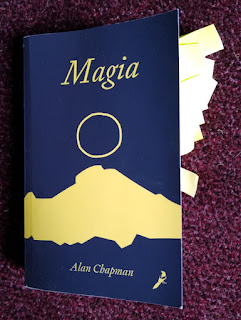This Is Chaos, edited by Peter J Carroll
It's got quite a range of offerings, not all of which were to my taste; but of course that's how it is with anthologies. Personal takes on the history of CM from Pete Carroll and Jaq Hawkins, some good articles full of basic practical hints, and just for variety, one of those pieces which tell you how you must do magic.
Lionel Snell is of course represented, with a great piece, Virtual Reality, Cybermagick and the Future of Chaos, resuming one of the main themes of his work over the last 50 years - VR. He is the man who invented Johnstone's Paradox, the idea that, if it's ever going to be actually possible to upload human-level consciousness into computers, then the odds are we are already living in such an emulation. This theory is now claimed without attribution by shameless plunderers of Lionel's originality. The essay ends with this computer analogy, symbolizing coding as magic, and the consensus world as the desktop:
'The moral of my story is this: if you want significance, colour, and excitement, then explore magic and quest for meaning; but if you want fame and fortune, do what the politician does - dumb down and concentrate on life's materialist desktop.'
Yes! He also proudly flies his chaos-heretic flag by ending the piece with some astrological reflections.
Another fine piece is Julian Vayne's Chemognosis Redux, reminding us of the timeless links between magic, chaos magic in particular, and getting high.
The real stand-out piece for me though was Mariana Pinzón's Octomantic Neuro-Hacking: A Map and a Compass for ChaoSurfing. She maps the 8 Colours of Chaos onto the Leary-Wilson 8 Brain Circuits model. This is not only a highly original approach (though owing some nuances to the work of Antero Alli) but also a highly practical one: Pinzón gives types of exercises for each Circuit/Colour, based on her extensive experience of running workshops with this model.
I opened up some possibilities for this kind of thinking with Chaotopia! in 1997, but the real originality in Pinzón's work is in the reduction in hierarchy, the flattening of Leary's evolutionary ladder, cluttered with his later accretions about future progress. So each circuit can be seen as a branch of a total web of magical work, both for internal development and for the attraction of experiences we need.
Another nice feature of her work is the way she divides the 8 circuits into Order (Cs 1-4) and Disorder (Cs 5-8), pointing out that Chaos is not the opposite of Order, but gives rise to both Order and Disorder. This is an important philosophical nuance that, as far as I'm aware, no chaoist had previously spotted.
My piece is Collective Spirits: Egregore Entities and Online Magic, an exploration of the IOT's egregore work and its potential for online spellcasting.
The book is very nicely designed and illustrated. The cover art and the extensive internal pictures are the work of Hagen von Tulien. In these images I see artistic genes from Austin Spare, and Brian Ward (who did the art for Psychonaut & then disappeared. Anyone fancy a psychic quest for him?)
I'd recommend the book for its few outstanding essays.




Comments
Post a Comment